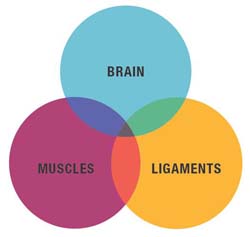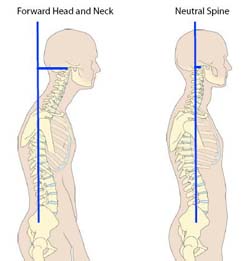By Dr. Brian Paris, DC
Creator of the Lose the Neck Pain System

Worst Mistake? Not Treating the Underlying Cause!
When dealing with neck pain or stiffness, do you simply fight through the pain? Or do you choose to cover up the symptoms with over-the-counter or prescription medications?
Either way, BIG mistake.
Ignoring neck pain usually means the underlying problem will only get worse as time passes. This may even lead to a permanent neck injury down the road.
Do you really want to take that risk? I’d strongly advise against it.
Outside of accidents, neck pain rarely happens overnight. More often than not, it develops from a lifetime of bad postural habits.
Over the years, these bad habits create muscle imbalances which lead to long-term postural distortions and, inevitably, chronic neck and upper back problems.
That’s why it’s so important to understand what postures contribute to neck pain, why you naturally tend to remain in those postures, and how to correct them.
Neck Pain: Not All In Your Neck
The underlying cause of neck pain — bad posture — doesn’t lie solely in your neck. Your brain, muscles, and ligaments all interact with each other and determine how you sit, stand and move around.
If one or more of these three postural forces are at fault, your posture suffers and you end up with neck pain or stiffness.

Neck pain is often caused by more than just your neck
#1: Your brain
Your brain constantly gets feedback from all over your body. It uses this feedback to create a 3-dimensional “picture” of yourself in space.
As you develop bad postural habits over time, your brain’s idea of a “correct” posture shifts as well. Once this happens, your brain no longer realizes that your posture is unbalanced and unhealthy and actually works against your efforts to maintain good posture.
#2: Your muscles
When you have a normal, healthy posture, the muscles of your neck, shoulders and back have an ideal length-tension relationship. They correctly manipulate your spine forward, backward, and sideways.
When you maintain bad posture, this relationship in your muscles becomes unbalanced, leaving them unable to do their job properly. These muscle imbalances limit your spinal mobility and function while forcing your body into long-term dysfunctional postures.
#3: Your ligaments
Your body was meant to walk, run and jump — to move. If you spend most of your time in fixed positions or performing repetitive tasks, your spine and the ligaments connected to it get molded into fixed, inactive positions. This causes them and the muscles around them to deteriorate and speed up the aging process.
Since all three of these forces play a role in neck pain, you have to ensure all three are fulfilling their proper role to get lasting neck pain relief.
What postures are killing your neck?
The most common cause of neck pain I see comes from our modern-day habit of hunching over or looking down for hours at a time.
Almost all of us do it to some extent. We hunch over steering wheels, work on our computers, and stare downwards as we text on our cell phone or play handheld video games.
 Think of an imaginary line that runs from your ears down through your shoulders and hips. A neutral, healthy posture when viewed from the side will show that line straight up and down from your ears through your shoulders and hips.
Think of an imaginary line that runs from your ears down through your shoulders and hips. A neutral, healthy posture when viewed from the side will show that line straight up and down from your ears through your shoulders and hips.
When your head juts forward of this imaginary line, your neck is forced to sustain much more weight instead of shifting the weight bearing lower into your body where it belongs. This common postural dysfunction is called Forward Head and Shoulders, or FHS.
For every inch your head moves forward of this neutral line, your neck muscles have to bear an additional 10 pounds of extra weight! This alone can lead to severe neck, shoulder, and upper back pain. The more severe the degree of FHS, the more weight your neck must support and the more pain you are likely to feel.
Months and years of this posture gradually results in the loss of your neck’s natural C-shaped curvature. The muscles in your upper back and back of your shoulders become overstretched and weaker. At the same time, muscles in the front of your shoulders and chest grow tighter.
This tug of war is what leads many older individuals to walk with a hunched back while complaining of chronic upper back and neck pain.
While FHS is the most common postural dysfunction behind neck pain, it’s not the only posture associated with neck pain. Those with movement restrictions preventing normal head rotation and / or head tilt exhibit another set of postures, sometimes in addition to FHS.
Again, muscle imbalances are primary contributors to these neck issues. These are often immediately evident after taking a photo from the front when standing in a “normal” posture. Examine the photo. Do you see a tilt or turn of your head in relation to your body even when you’re supposed to be looking forward? That’s a tell-tale sign of muscle imbalances causing these other common postural dysfunctions.
Now that you know the types of postures behind your neck pain, will you continue to cover up the pain by taking drugs that will eventually kill your stomach and liver? Or will you take action to identify why you have these muscle imbalances in and around your neck and naturally correct the postural dysfunctions behind your pain?
You can find a comprehensive guide to assessing your own postural dysfunctions and correcting them in the program I developed, Lose the Neck Pain.
I’ve used the techniques in this program for years with my own clients. While it takes time to correct years of poor posture, many of my clients have found near immediate neck pain relief through these exact techniques. I hope you’ll look into how it can help with your own neck pain.
Most Popular:
The World’s FIRST Customized
Neck Pain Solution



do you have an online version
Hi John,
Thank you for your query.
If you click on the link to lose the neck pain at the end of the article where it says “The World’s First Customized Neck Pain Solution”, then scroll down, you will see there is an online version of lose the neck pain as well-
Lose The Neck Pain Online Version
Receive instant access to the reference manual, 3 audios, the Lose The Neck Pain video and both bonuses…
Hope that helps, let us know if you have any further queries.
Thank you
I have scoliosis and I’ve recently been to a chiropractor and my x-ray showed that I have a 27 degree curve in my neck when it should be 45. The x-ray also showed that my upper spine in my back is curving towards my heart. I don’t know that degree of curve but they said that if I didn’t get the back curve straightened that I can end up with heart & breathing issues.
Is chiropractic adjustments the only way I can get the proper curve back in my neck and spine?
Thank-you.